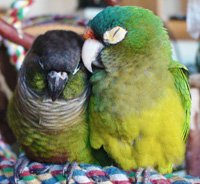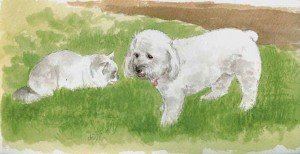We only use USDA human grade ingredients for our certified organic pet foods to assure the highest levels of quality and safety for your pet. Our use of USDA human grade ingredients guarantees that your pet will never be exposed to the kinds of low-quality ingredients of questionable nutritional quality and origin that are too often used by conventional pet food manufacturers to optimize their cost/profit ratio. Organic certification has the further advantage for the consumer that s/he can be assured that no cheaper, less healthy non-certified organic (conventional) ingredients are used if organic varieties are available.
Feed-grade ingredients include very low quality components, such as meat byproducts, which cannot even be traced to their original animal source. In other words, you don’t know what you’re pet is eating. When pet food companies defends the use of byproducts with the argument that dogs and cats in the wild are arbitrarily eating the remains of various animals, you really need to inform yourself more about what byproducts—and their ugly cousins, ‘animal meals’ and ‘rendered fats’—may actually contain. The answer is very distressing: euthanized animals containing the toxins used to put them down, as well as animals discarded after lab experimentation. This is no scary fairytale, but an actual fact. Both the USDA and FDA are aware of this, and you’ll find, listed openly online their unbiased information—and warnings—for pet food processors who choose to use these kinds ingredients about proper handling of these components. Other similarly untraceable ingredients include most so-called ‘meals’ (such as ‘chicken meal,’ which can include any part of a chicken other than muscle meat), ‘animal fat’ and ‘animal protein,’ both of which may contain mostly mixtures of fats and proteins from a variety of unidentified animal species, ‘vegetable oil’ which may contain mostly mixtures of oils from a variety of undefined plant sources. Probably the most startling revelation for pet owners is that these undefined pet food components cannot be traced to the precise source, should a health problem arise. For instance, if your animal became ill after eating a few meals, you might know what brand of food got him or her sick, but, if the ingredients used were of such low quality that they couldn’t be traced back to a particular farm, let alone an animal species, it’s possible that your pet’s illness would progress—even to the point of death—before the problem was identified or, at the very least, the products containing the tainted ingredient were off the store shelf and discarded from pet owners’ pantries.
This is the principal reason why we wouldn’t even consider using ‘feed-grade’ ingredients in our pet foods, and it is why we choose to use exclusively human grade ingredients. Here’s a real-life example of the importance of our choice. When I heard that even certified organic eggs are offered both as cheaper feed-grade-quality and more expensive USDA human grade-quality, I asked myself—and queried egg suppliers—what the difference was. Now, after I heard about the mere existence of feed-grade eggs, I had vague ideas about what the difference in quality might mean, but I never received any answers from suppliers. So I decided to go with human-grade eggs for any future pet food applications because I simply didn’t want to get into a foggy area where the health and wellbeing of peoples’ pets consuming such products (and the welfare of the producing hens) might be compromised just to save a buck and increase my company’s profits. In our eyes it is unethical to abuse and to inhumanely treat any animal that is raised for food for both humans and animals which we choose to keep as pets. Although USDA inspections are rare due to this agency’s ridiculously low budget and man power, the threat of fines and the possibility of inspections provide at least some incentive to treat animals according to the legally set rules. In our eyes, the use of human-grade ingredients that are derived from humanely raised and humanely treated animals, is the only responsible way to make pet foods that contain animal-derived ingredients.
Although the use of USDA human grade ingredients per se is absolutely no guarantee that the resulting pet food—or human food, for that matter—is healthy, it takes away some of the unknowns, examples of which I just described.
Some examples of unhealthy USDA certified, human-grade, pet food ingredients include the following:
Sugars, which can cause overweight and obesity and which can play havoc with your pet’s insulin production and overall metabolism. Honey is often added to dog and especially cat foods to increase palatibility and consequently product sales, however, the problems of routinely eaten honey are the same as with any simple sugar;
Artificial sweeteners, which in high doses have been shown to cause cancer;
Refined salts (e.g., your garden-variety table salt, or sodium chloride), which, among other things, can cause mineral imbalances;
Refined flours, which can cause excessive weight-gain and obesity;
Low grade synthetic supplements, which can be of so poor quality that the impurities accumulated during manufacturing alone can be toxic;
Isolated ‘food fragments,’ which can cause a variety of health problems, including allergies and chronic inflammation.
Obesity has become an epidemic among both people and their pets in the Western world. This epidemic is directly related to the far-too frequent choice of unhealthy foods, and is associated with a growing number of health problems, including diabetes, hypertension, stroke, heart disease, and even some types of cancer.
The 100% USDA human grade pet foods created by Onesta Organics do not contain refined ingredients. When we formulate our products, we are always mindful, not just of the importance of USDA certification of ingredients in assuring quality and maximizing safety, but also fundamentally what the right choices of ingredients are from the perspective of promoting good health and well being among the ultimate Onesta Organics consumers: your pets.
A prominent example of what’s wrong with the conventional pet food industry being whitewashed by the use of USDA certified human grade ingredients are dog foods made primarily from USDA certified human grade refined grain flours, as well as dog food products which include known canine allergens such as corn, gluten, grains, rice, or soy. Think about it: if a dog food manufacturer includes one of these known allergens in their product, they must not be terribly concerned about the possible negative impact on the health of many of their customers’ pets! The choice of such ingredients should send a clear warning to customers, even if a given company’s PR and marketing materials try to convey an honest and health-oriented intent. There is certainly at least one company out there that lists ‘100% organic grains’ as the first ingredient in their dog food. So, ask yourself: does this company think that all of their customers are ignorant of the fact that many dogs are allergic to grains? No, not likely. Certainly, even human grade grains are much cheaper than most high quality, non-allergenic sources of protein! The funny thing about this particular pet food company, which shall go nameless—you know who you are—is that, even as they claim that the grains they use in their organic dog foods are organic, they nevertheless fail to provide for public inspection an organic certificate for any of their products (or ingredients contained in those products) that would substantiate their organic claims.
The aforementioned pet food company provides a good example for the concerned pet owner of the various things to watch out for when looking for a human grade dog or cat food. To drive home the point even more solidly, I’ll just mention some other claims they make in marketing their products as examples of what to avoid. This company advertises that the produce they use is 100% GMO-free, and that the meats they use are both hormone- and antibiotic-free. Well, these are certainly big claims to make, particularly when one considers that not a single one of their products is certified organic, which would automatically guarantee that the ingredients used are free of hormones, antibiotics and GMOs. There is simply no way to substantiate their claims of ‘antibiotic-free,’ ‘hormone-free,’ or ‘GMO-free’ because no organic certificates for these ingredients—or any other 3rd party certification that could attest to these claims—is available for inspection. So, without any proof, this company’s claims about their pet foods may or may not be true. So, given an increasingly lucrative market for organic and human grade pet food products, would you trust this company and it’s claims?
So, here’s the essence of the foregoing discussion: the quality and provenance of human grade pet foods are only reliable when they are verified by unbiased third parties. In the case of organic certification, each ingredient used in the manufacture of a given pet food is inspected and its quality is checked with both the list of ingredients and any claims presented on the product label. Ingredients used for USDA certified organic pet foods cannot legally contain GMOs, antibiotics or hormones. The for the organic certification required complete disclosure of ingredients used and their sources will show whether USDA human grade or feed grade ingredients are contained in a given product. Since USDA-accredited certifying agencies are independent from the company submitting their products for organic certification, and these certifiers will look carefully at the product packaging and the claims presented therein, these certifiers will likely find out whether a company’s claims of human grade ingredients are actually valid.
In conclusion, the best USDA human grade pet food is also USDA certified organic, i.e., made with ingredients that are not only USDA human grade, but also healthy for your dog, cat, or other variety of pet. The food in question should not contain refined ingredients or known allergens. Neither low grade nor human-grade synthetic supplements are good choices for your animal. If a claim made on a label or in marketing materials looks too good to be true, and you don’t see any evidence to substantiate that claim, don’t purchase the product in question until you contact the company making the claim and ask them for evidence—such as third-party certification—to substantiate the claim. If you urgently need a good pet food product, buy one that presents you with up-front, solid evidence of superb quality and healthfulness; look at the ingredients carefully and look for the USDA certification and/or the name of a third-party certifier. Don’t forget that even humble USDA human grade pet treats should be as healthy as possible, even if you give them to your pet only occasionally. Remember: you—not a large pet food manufacturer—are the ultimate guardian of your pet and his or her good health and happiness!
 Posted by Heidi Junger, PhD under
Posted by Heidi Junger, PhD under  General - Pet Food, Onesta Organics Pet Foods
General - Pet Food, Onesta Organics Pet Foods  Comments Off
Comments Off

 … and animals love each other and Onesta Organics pet foods!
… and animals love each other and Onesta Organics pet foods!
